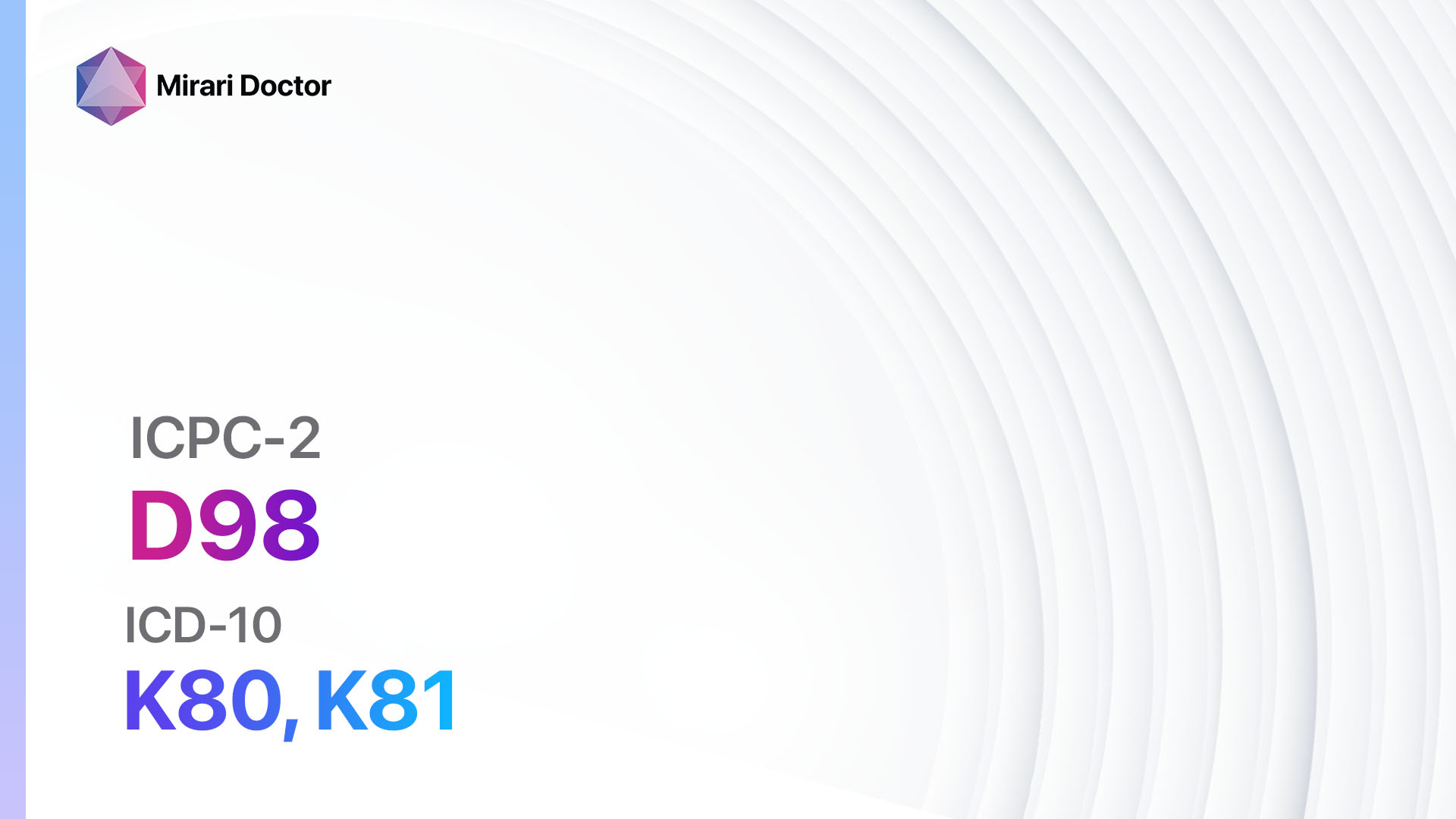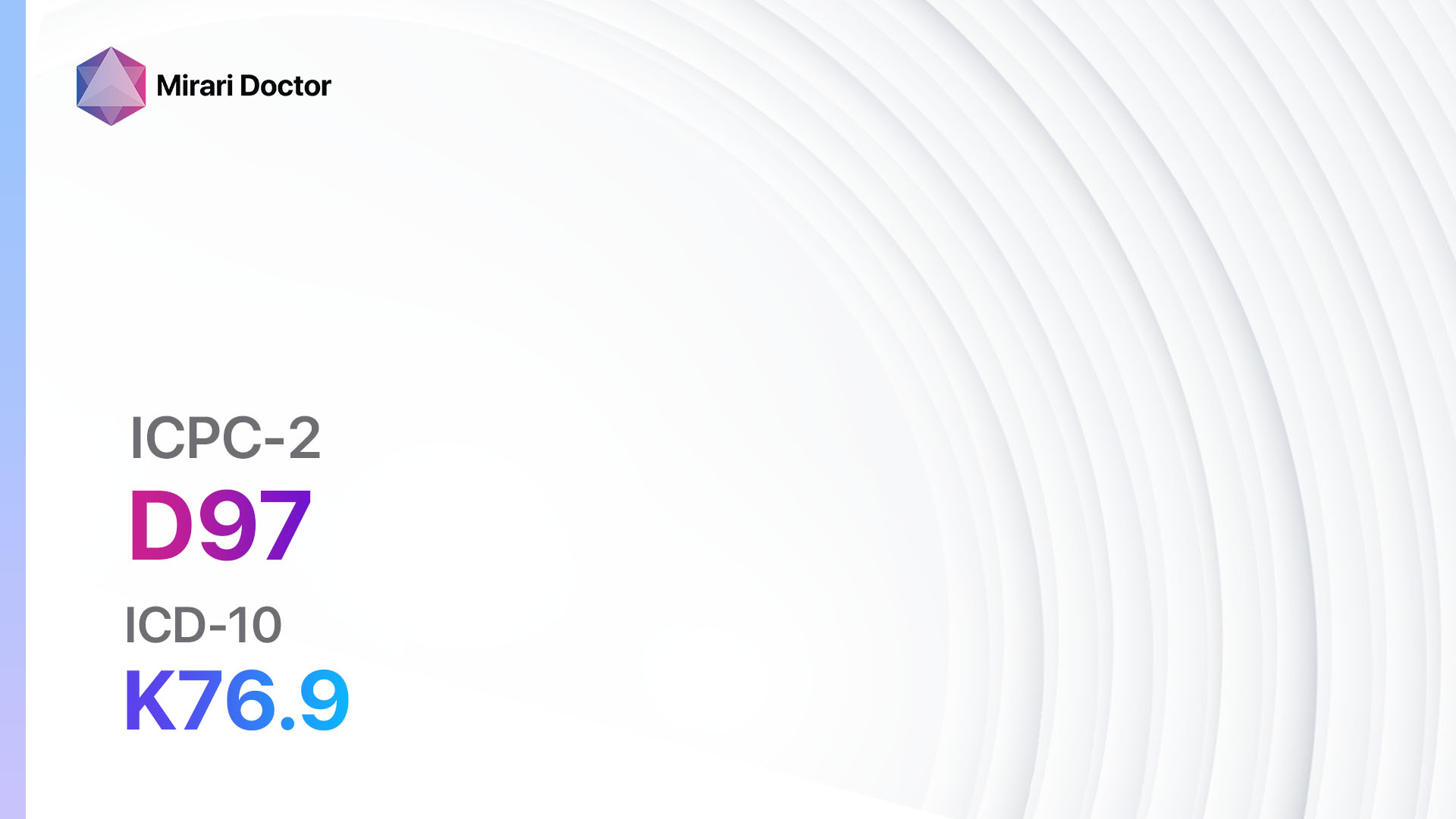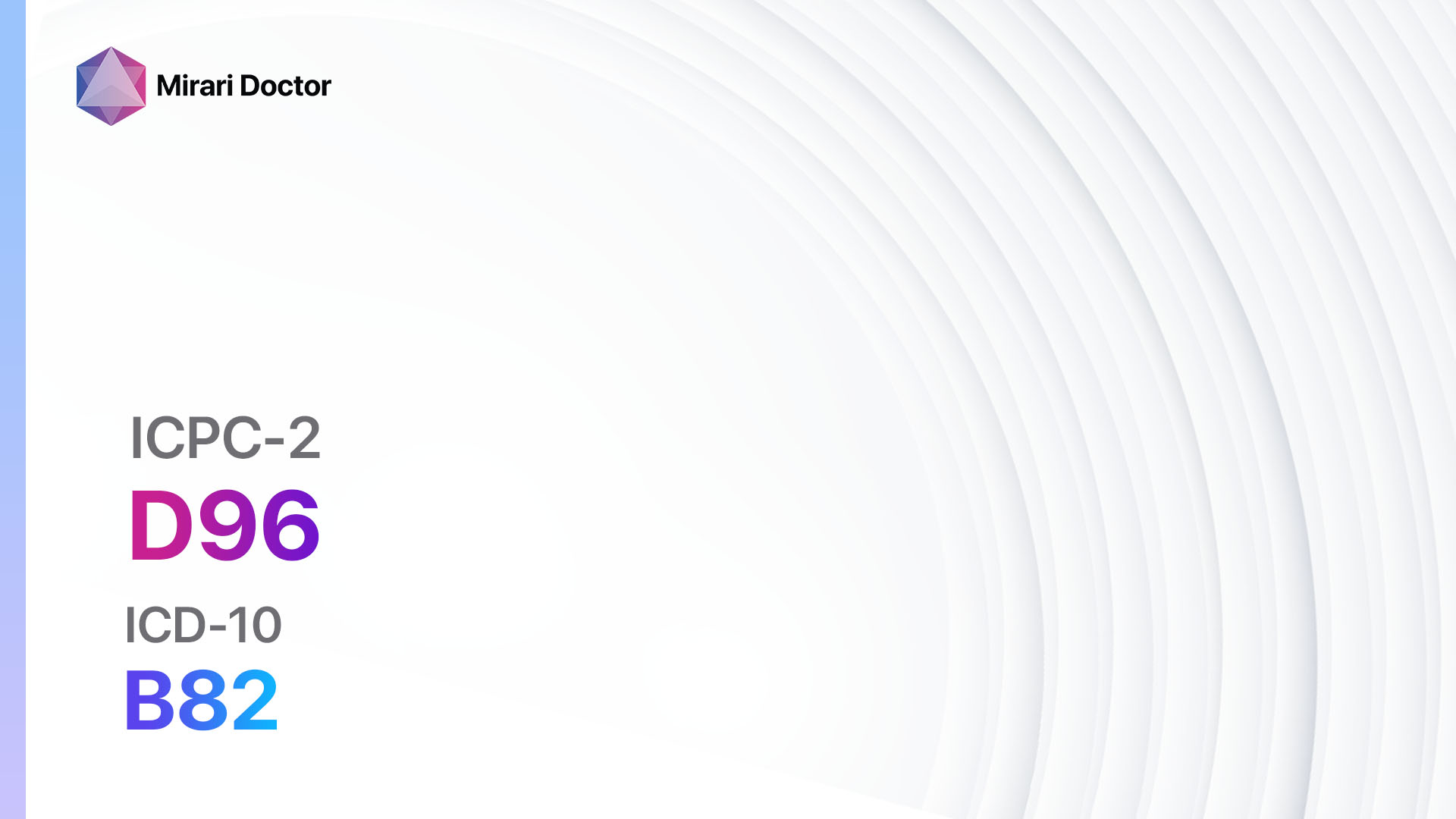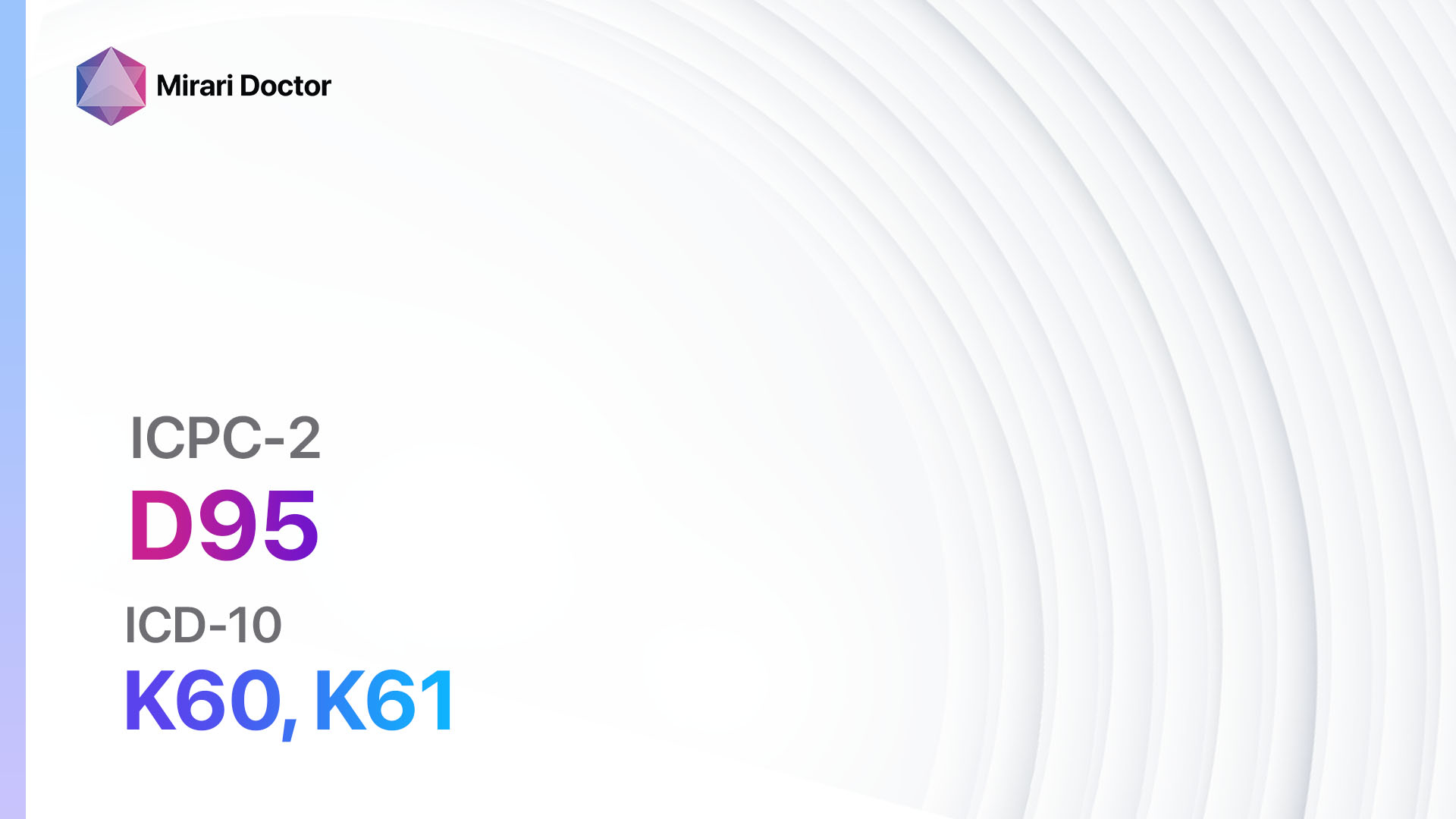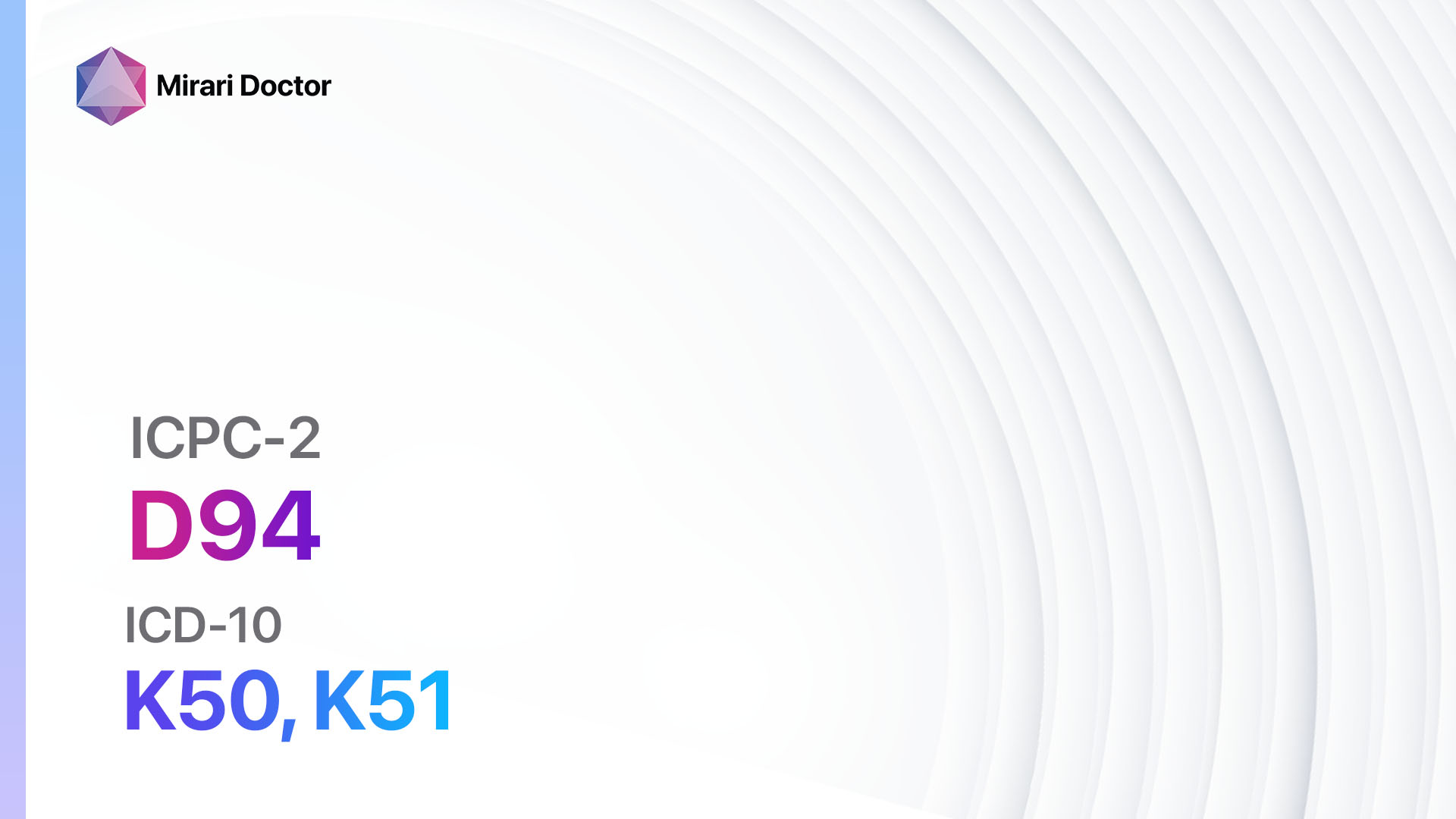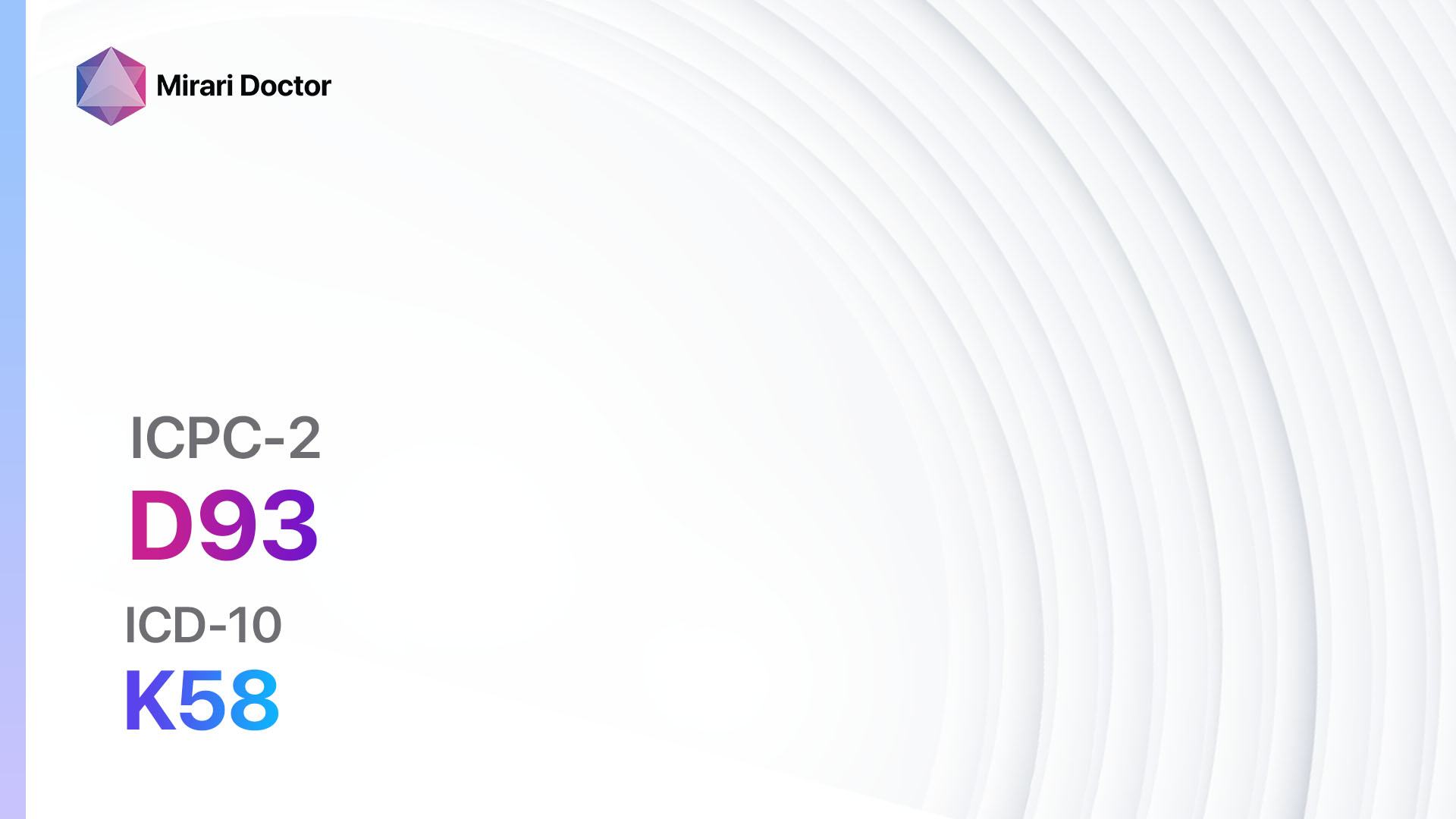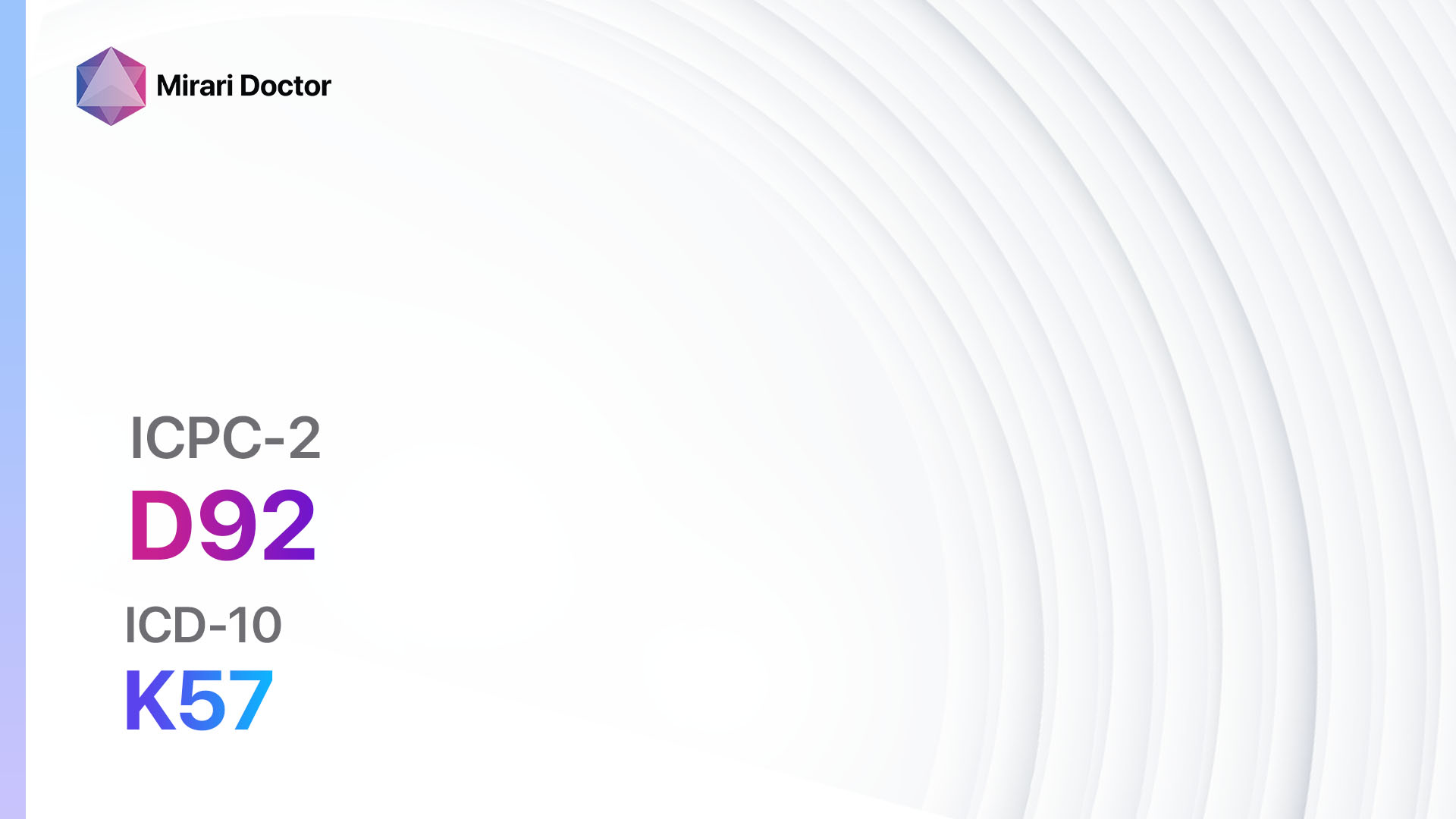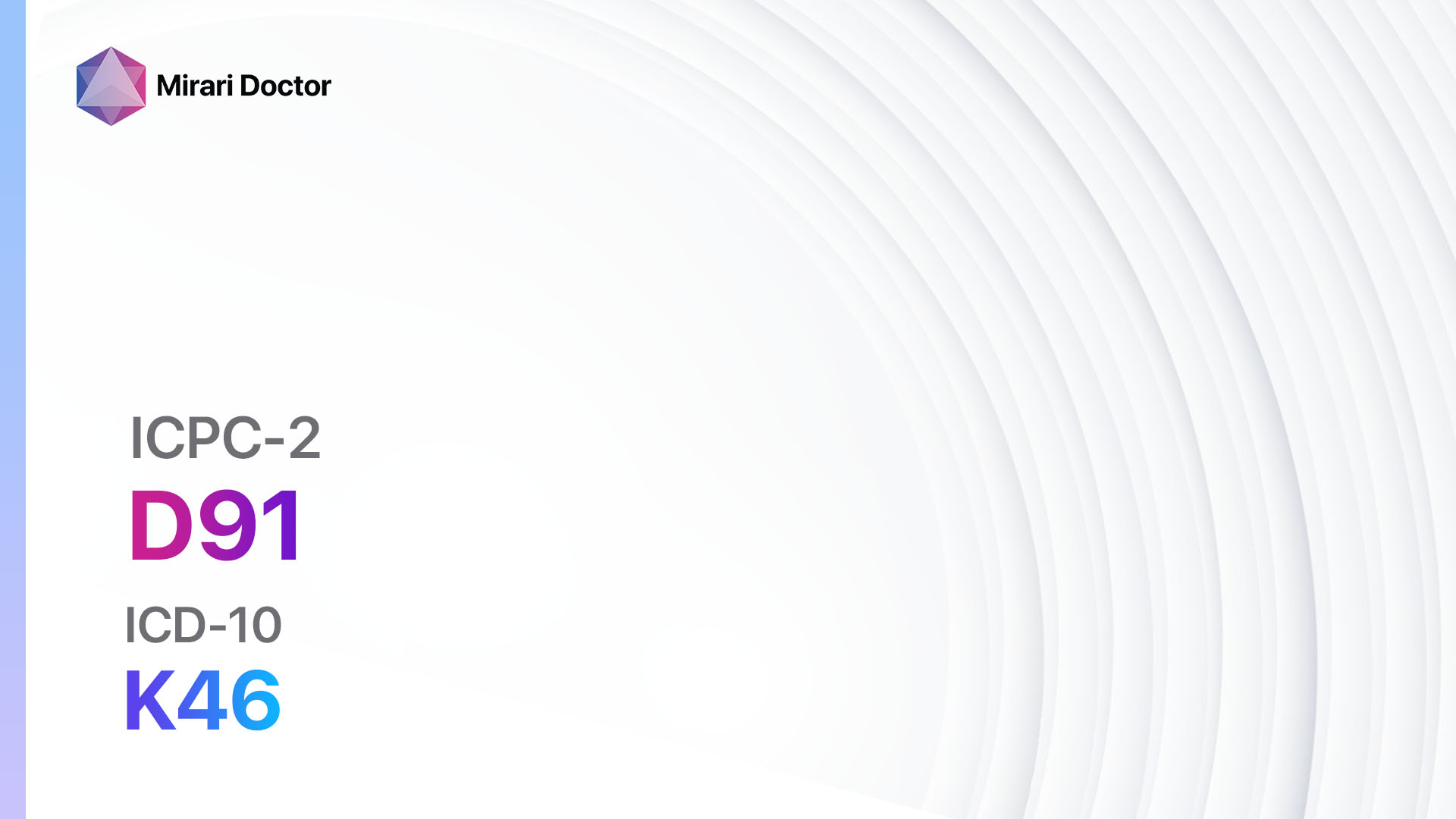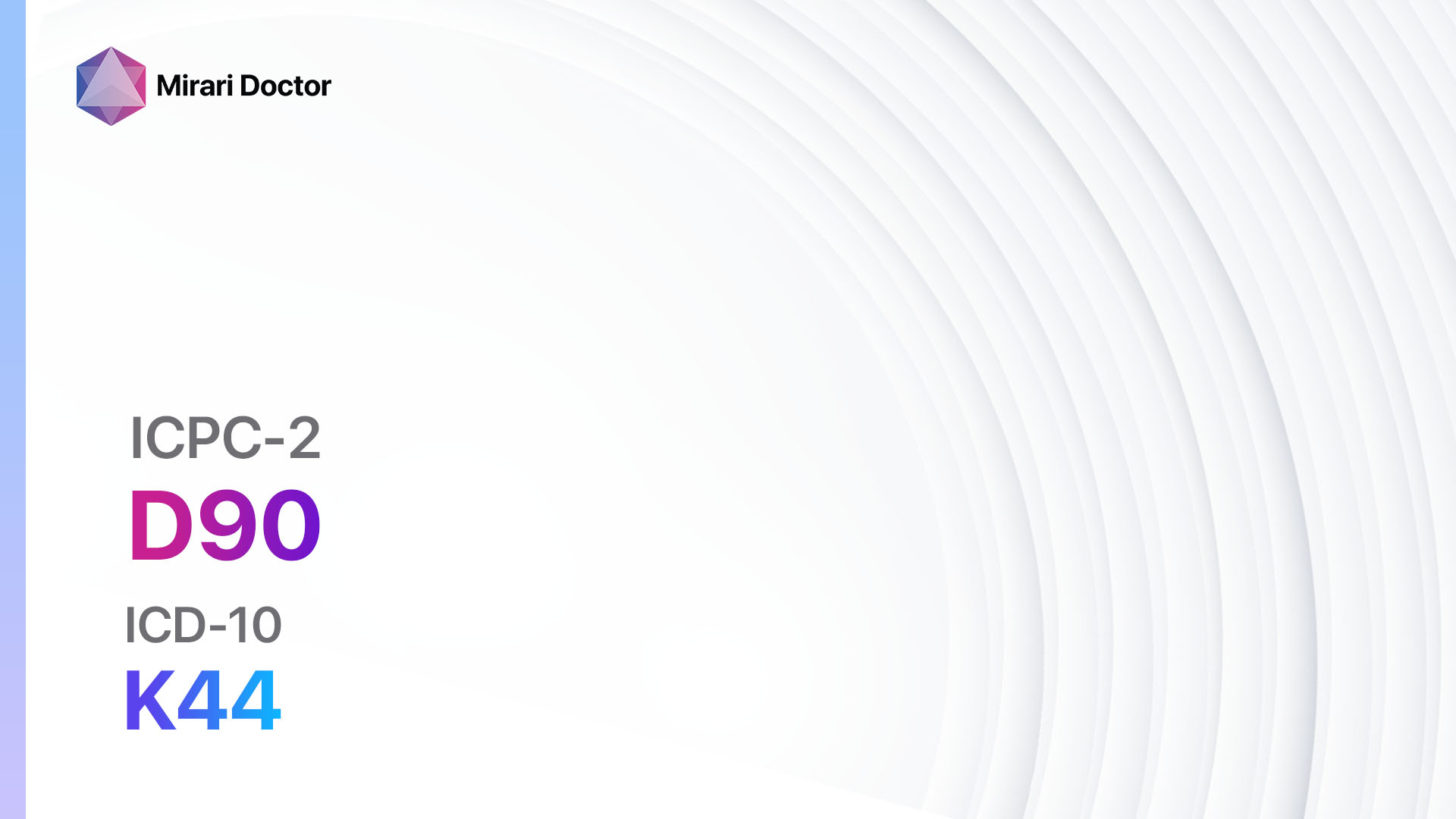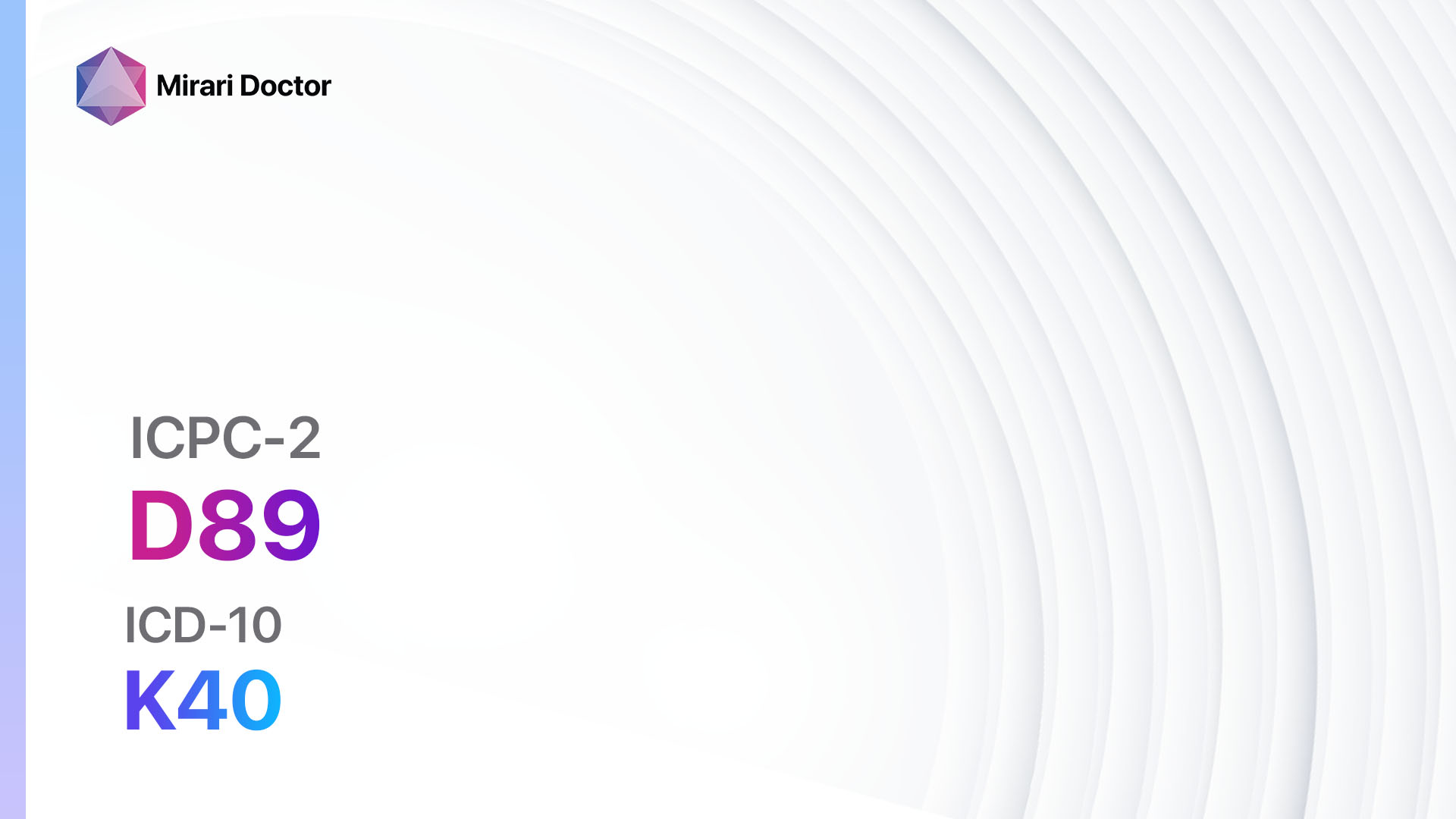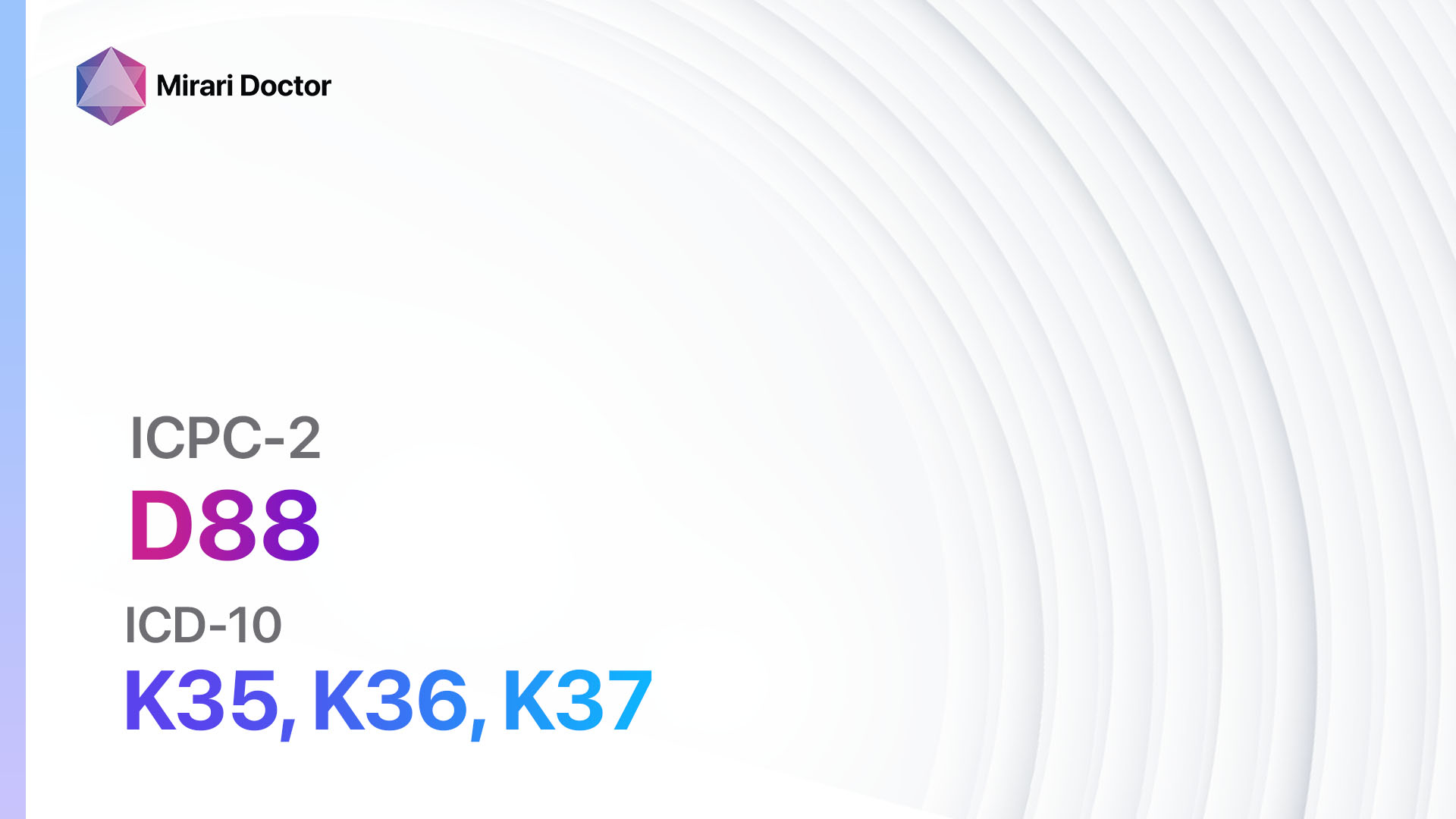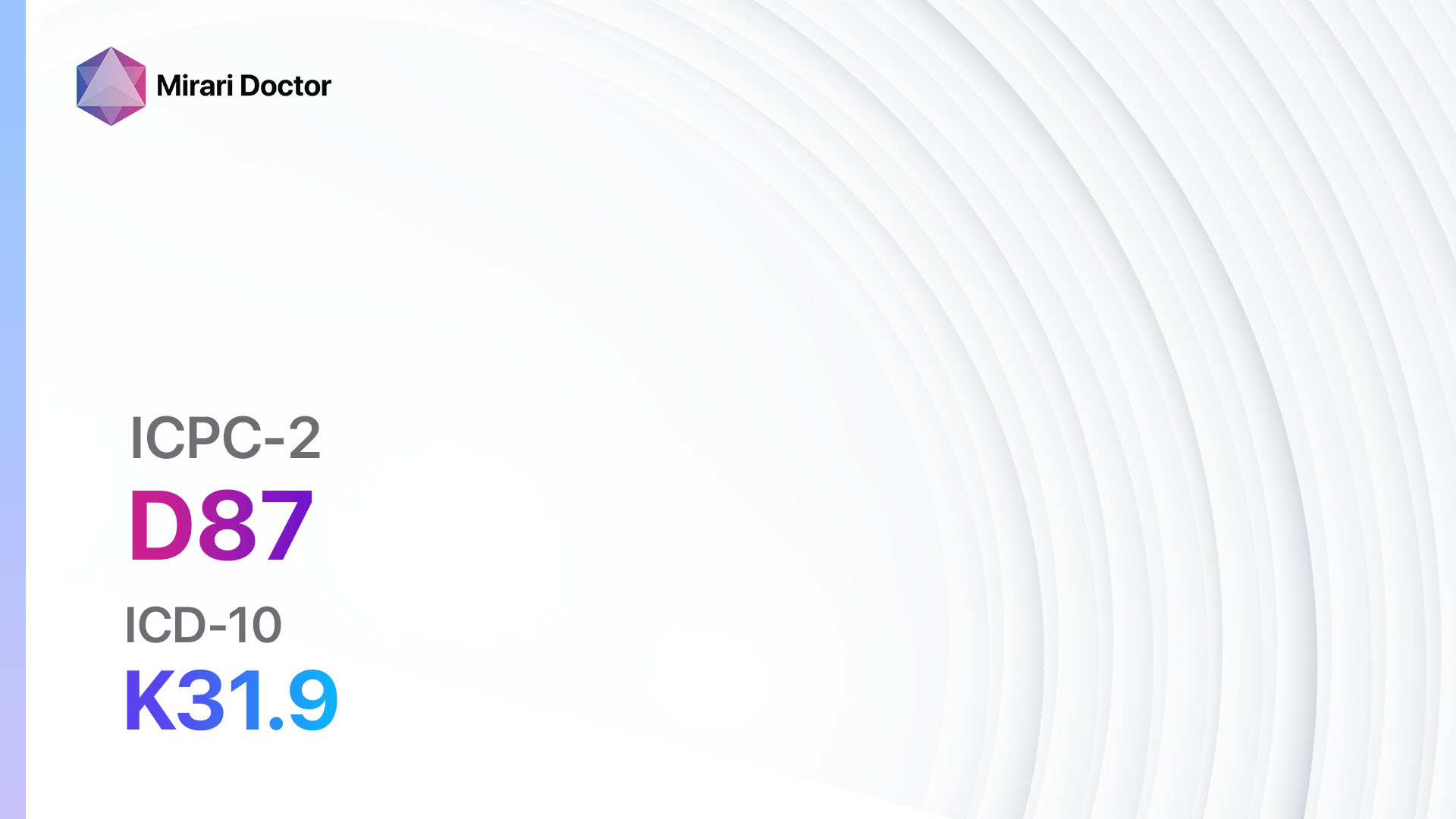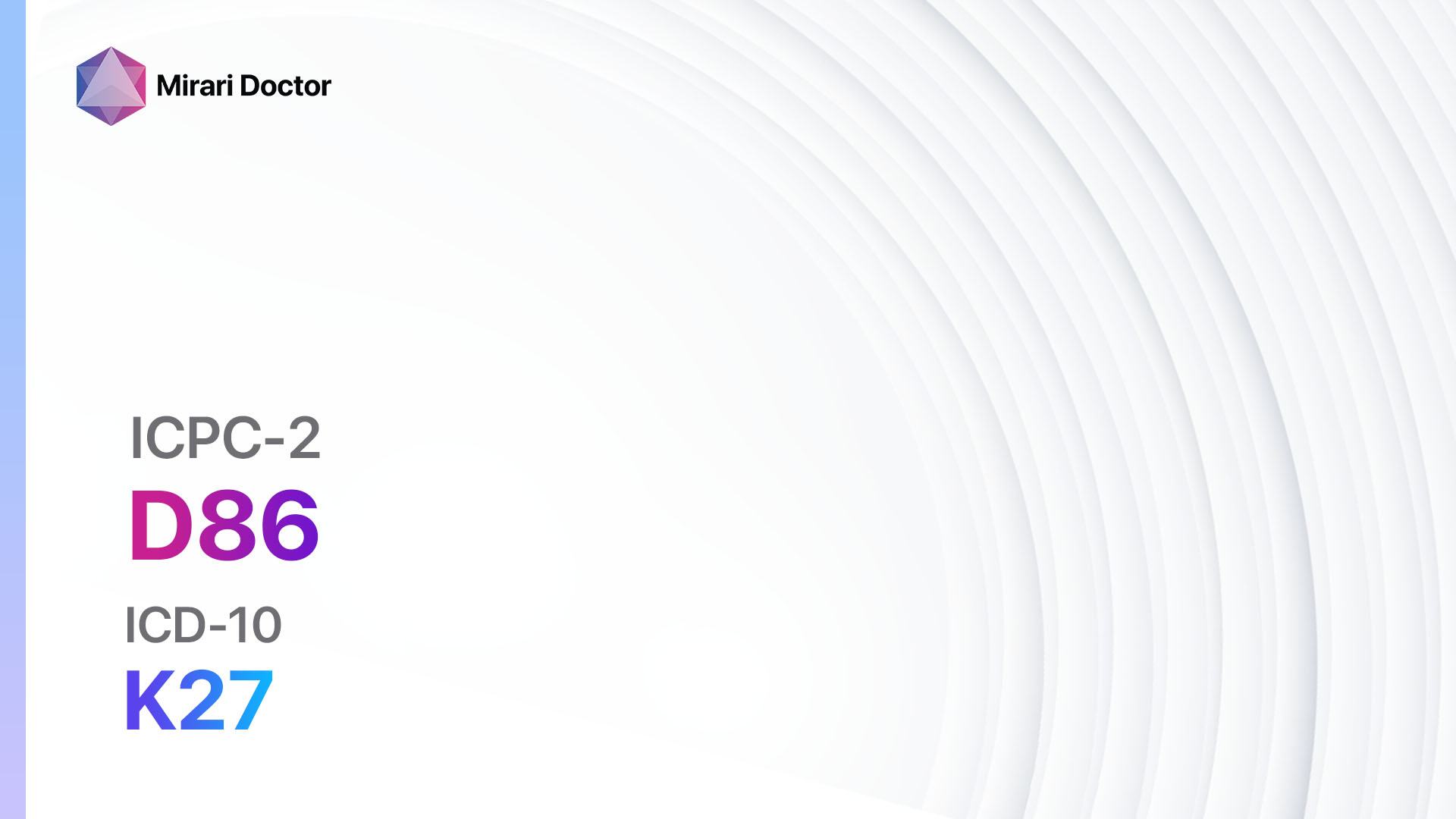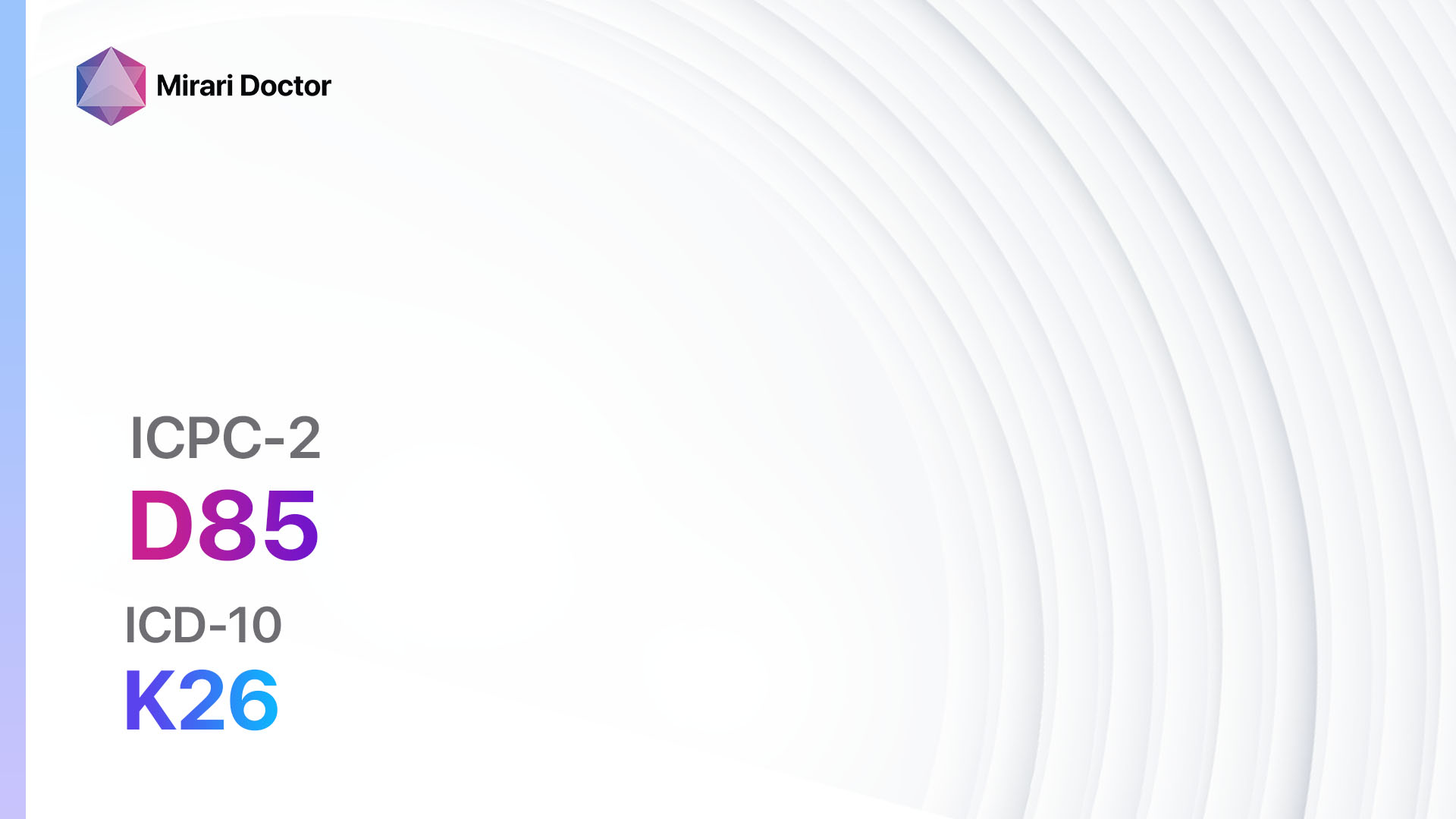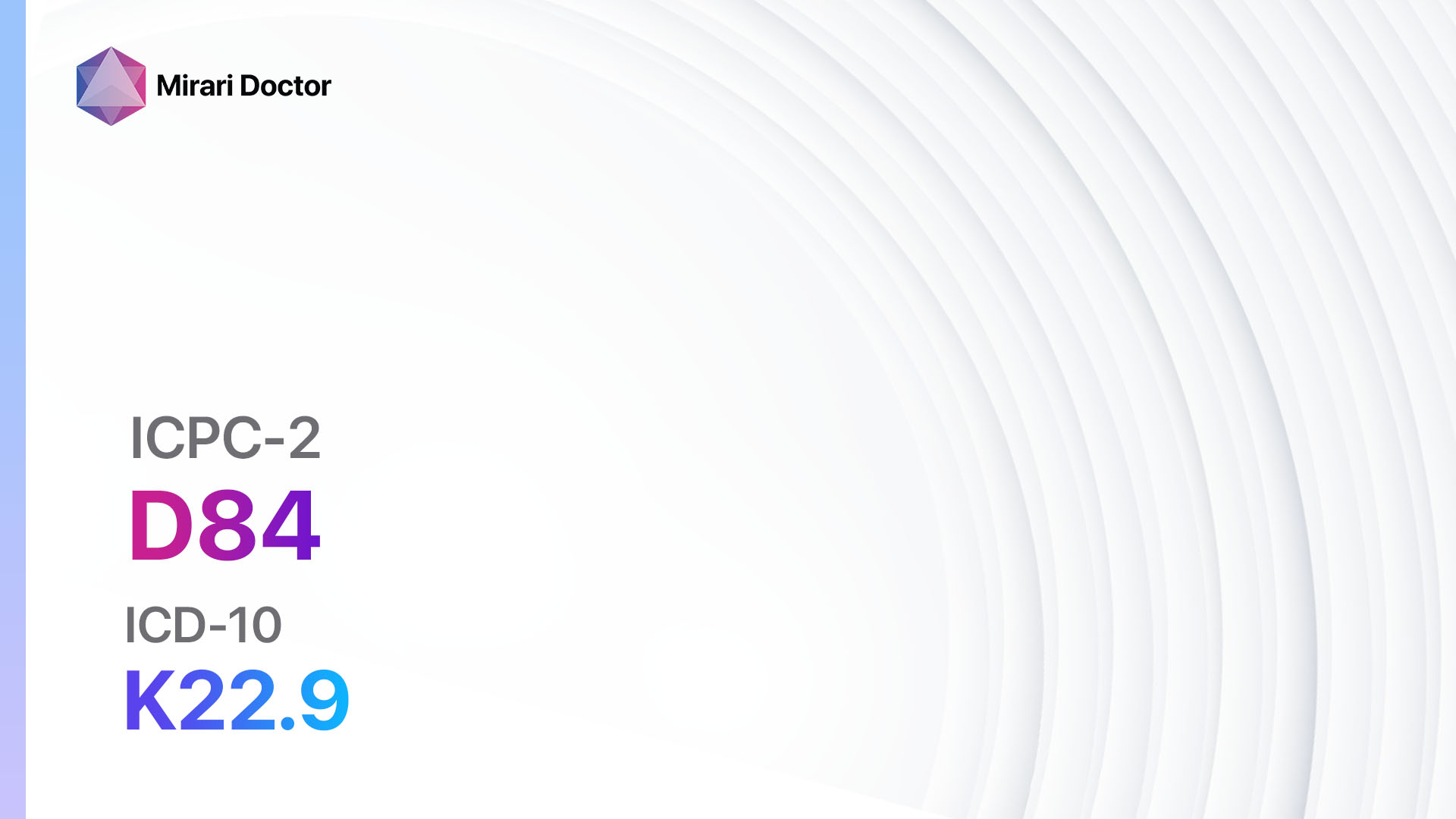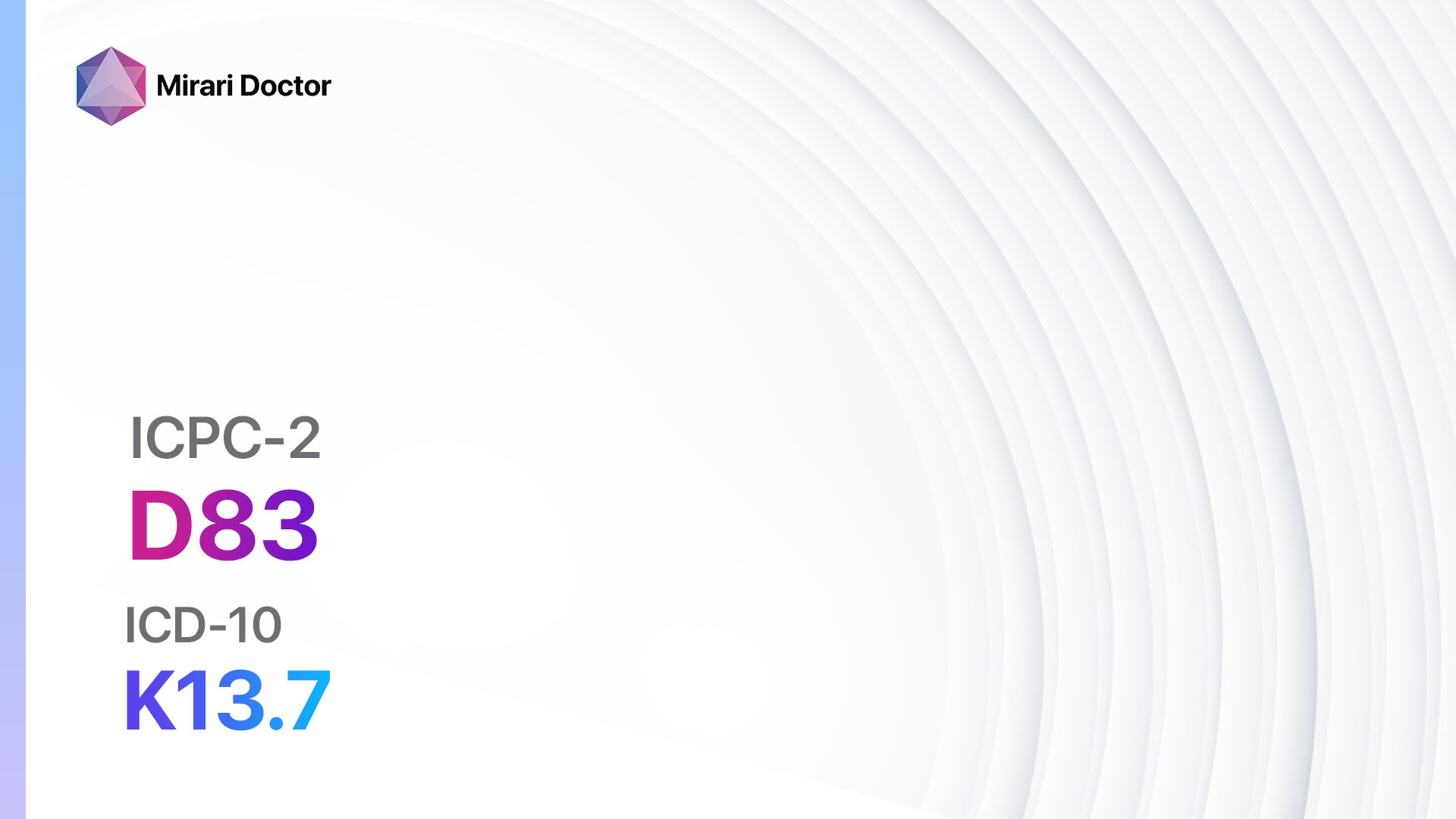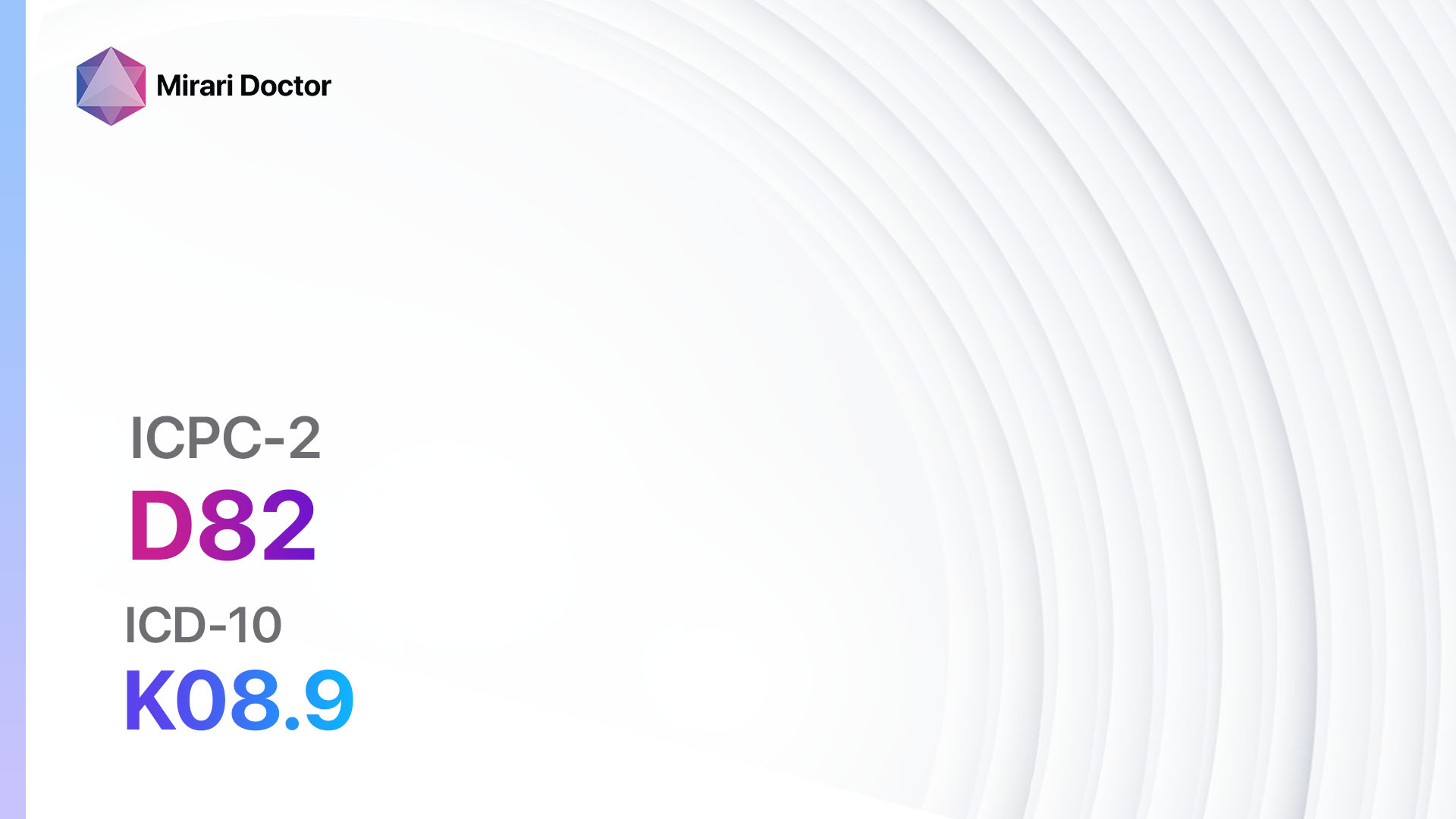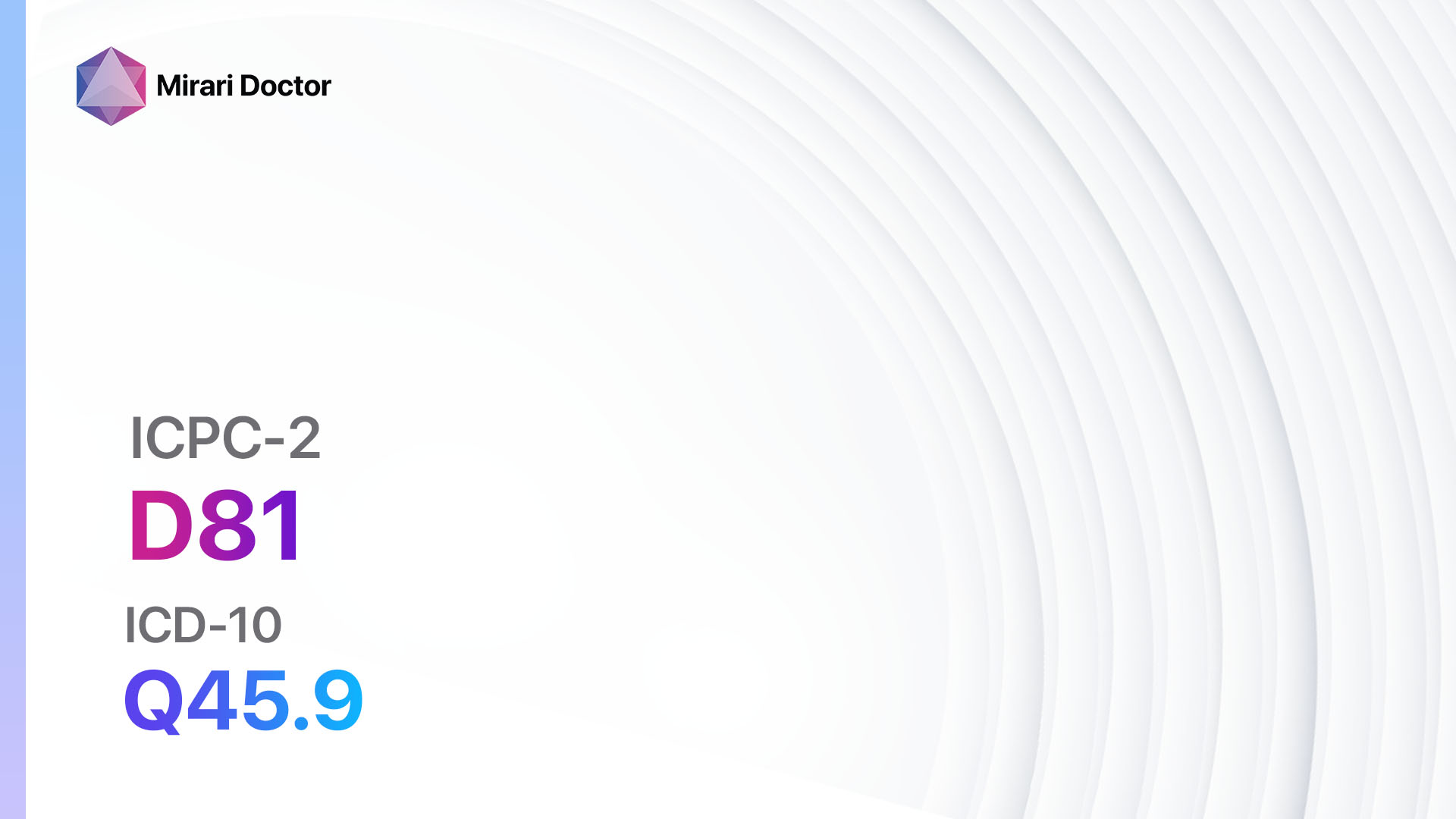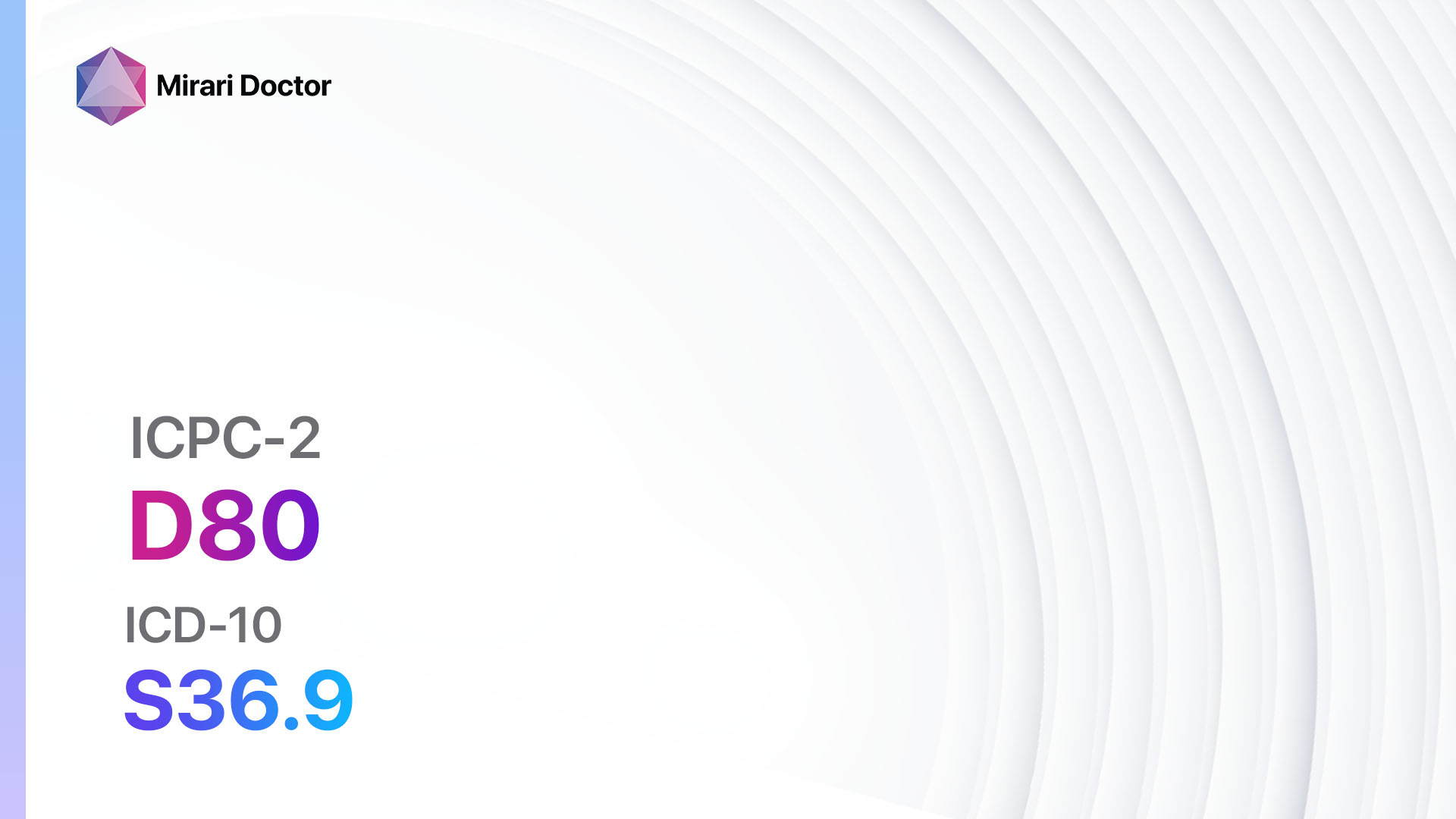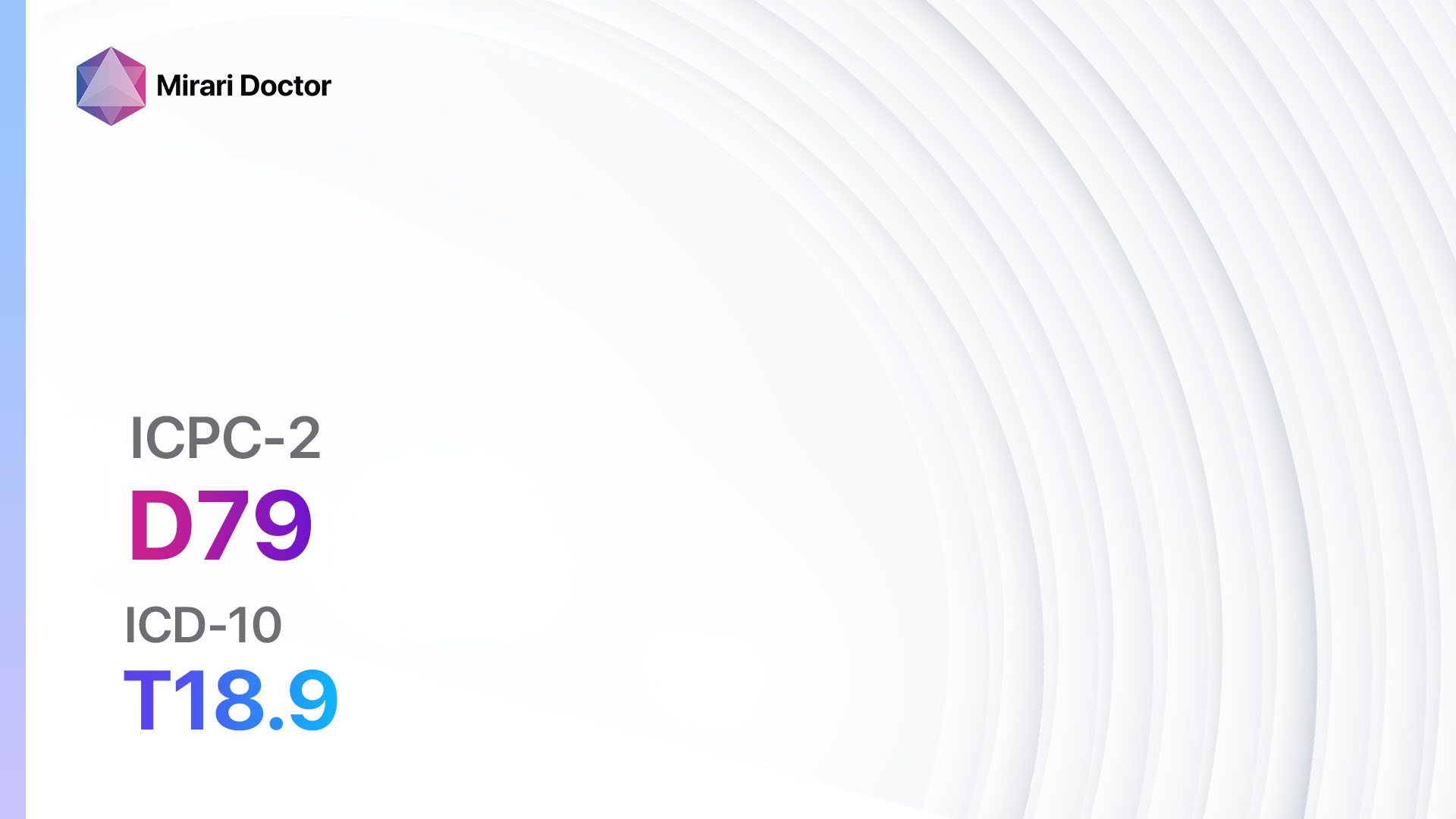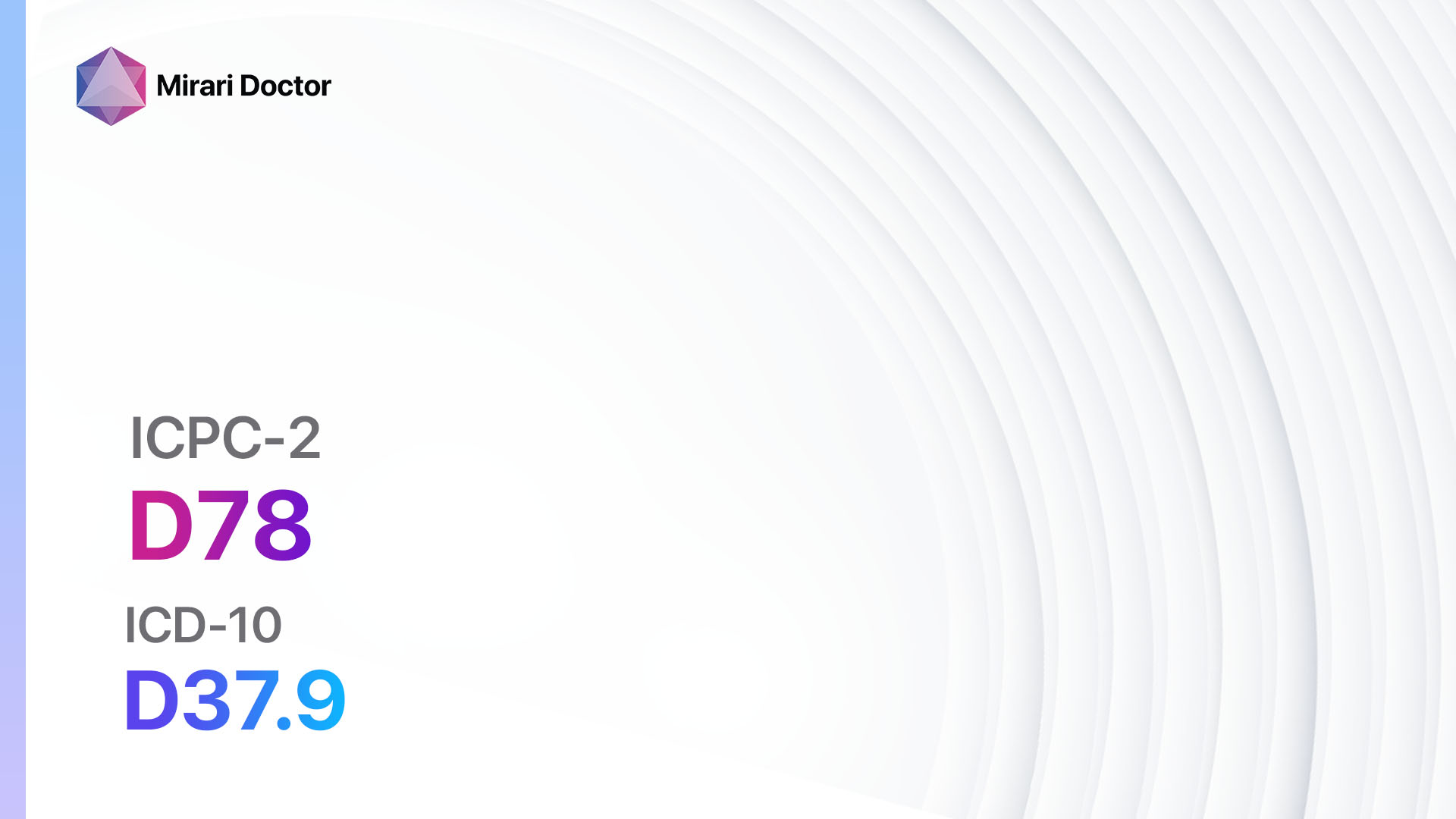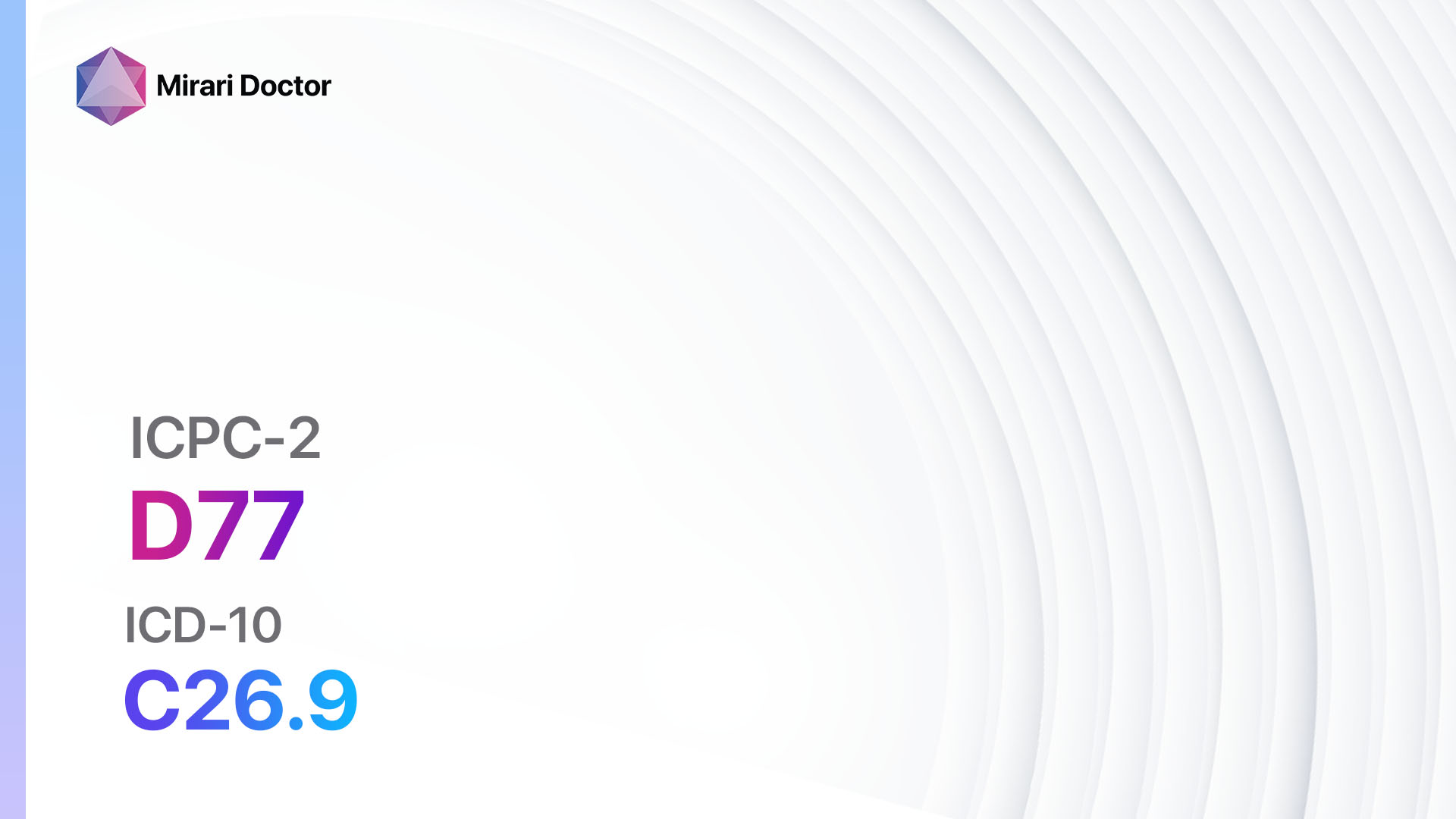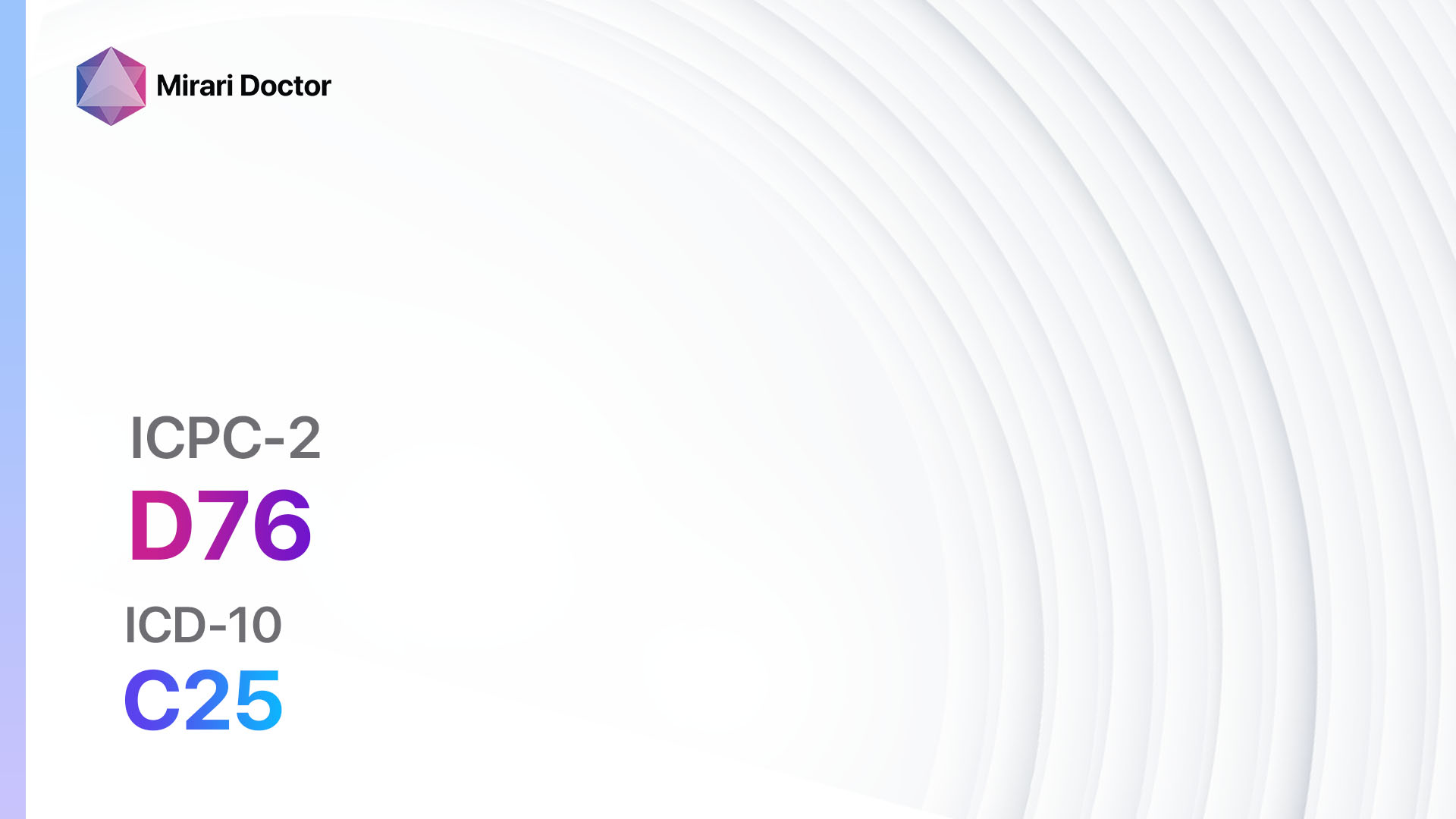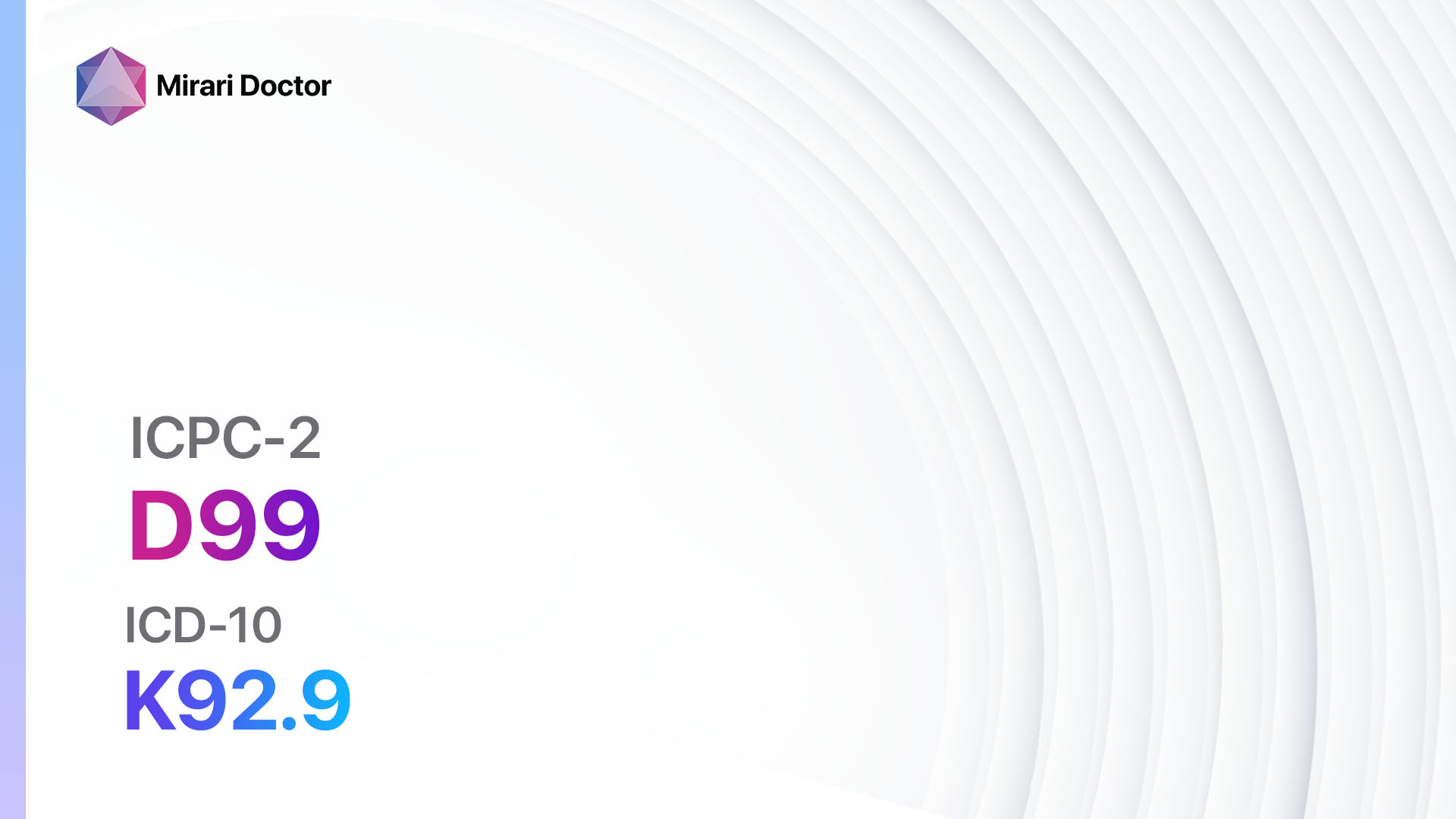
Introduction
Disease of the digestive system, other (ICPC-2: D99) refers to a range of conditions that affect the digestive system but do not fall into specific disease categories. These conditions can cause a variety of symptoms and may require different diagnostic and treatment approaches. The aim of this guide is to provide an overview of the symptoms, causes, diagnostic steps, possible interventions, and lifestyle interventions for disease of the digestive system, other.[1]
Codes
- ICPC-2 Code: D99 Disease digestive system, other[2]
- ICD-10 Code: K92.9 Disease of digestive system, unspecified[3]
Symptoms
- Abdominal pain: Patients may experience generalized or localized pain in the abdomen.[4]
- Changes in bowel habits: This can include diarrhea, constipation, or alternating between the two.[4]
- Nausea and vomiting: Patients may experience feelings of nausea and may vomit.[4]
- Bloating and gas: Patients may feel bloated and experience excessive gas.[4]
- Heartburn and acid reflux: Patients may experience a burning sensation in the chest and throat.[4]
- Weight loss: Unexplained weight loss may occur.[4]
- Blood in stool: Patients may notice blood in their stool.[4]
- Difficulty swallowing: Patients may have difficulty swallowing food or liquids.[4]
Causes
- Inflammatory bowel disease: Conditions such as Crohn’s disease and ulcerative colitis can cause inflammation in the digestive tract.[5]
- Irritable bowel syndrome: A functional disorder that affects the large intestine and causes symptoms such as abdominal pain and changes in bowel habits.[6]
- Gastroesophageal reflux disease (GERD): A condition in which stomach acid flows back into the esophagus, causing heartburn and other symptoms.[7]
- Peptic ulcers: Open sores that develop on the lining of the stomach, small intestine, or esophagus.[8]
- Gallstones: Hardened deposits that form in the gallbladder and can cause abdominal pain and other symptoms.[9]
- Pancreatitis: Inflammation of the pancreas, which can cause abdominal pain, nausea, and vomiting.[10]
- Food intolerances: Some individuals may have difficulty digesting certain foods, such as lactose or gluten.
Diagnostic Steps
Medical History
- Gather information about the patient’s symptoms, including the duration, severity, and any triggering factors.
- Ask about the patient’s medical history, including any previous digestive system conditions or surgeries.
- Inquire about the patient’s family history of digestive system disorders.
- Assess the patient’s dietary habits and any recent changes in their diet.
- Determine if the patient has any risk factors for digestive system disorders, such as smoking or excessive alcohol consumption.
Physical Examination
- Perform a thorough abdominal examination, checking for tenderness, masses, or abnormal sounds.
- Check for signs of dehydration, such as dry mouth or decreased skin turgor.
- Assess the patient’s overall appearance and vital signs.
- Examine the patient’s mouth and throat for any abnormalities.
- Palpate the patient’s lymph nodes to check for enlargement.
Laboratory Tests
- Complete blood count (CBC): This test can help identify signs of infection or anemia.
- Stool analysis: A stool sample can be analyzed for the presence of blood, parasites, or bacteria.
- Liver function tests: These tests can assess the function of the liver and detect any abnormalities.
- Celiac disease testing: Blood tests can help identify antibodies associated with celiac disease.
- Helicobacter pylori testing: This test can determine if the patient has an infection with H. pylori, a bacterium that can cause peptic ulcers.
Diagnostic Imaging
- X-rays: X-rays of the abdomen can help identify any abnormalities, such as blockages or masses.
- Ultrasound: This imaging modality uses sound waves to create images of the digestive organs.
- CT scan: A CT scan can provide detailed images of the digestive system and detect any abnormalities.
- MRI: An MRI can be used to visualize the digestive organs in more detail, particularly the liver and pancreas.
Other Tests
- Endoscopy: This procedure involves inserting a flexible tube with a camera into the digestive tract to visualize the organs and take biopsies if necessary.
- Colonoscopy: A colonoscopy allows for visualization of the colon and rectum and can help detect any abnormalities or signs of disease.
- Breath tests: These tests can help diagnose conditions such as lactose intolerance or bacterial overgrowth in the small intestine.
- Manometry: This test measures the pressure and movement of the esophagus and can help diagnose conditions such as achalasia or esophageal spasms.
Follow-up and Patient Education
- Schedule follow-up appointments to monitor the patient’s progress and adjust treatment if necessary.
- Provide the patient with educational materials about their condition, including information about dietary modifications and lifestyle changes.
- Encourage the patient to ask questions and address any concerns they may have.
- Refer the patient to support groups or counseling services if needed.
Possible Interventions
Traditional Interventions
Medications:
Top 5 drugs for disease of the digestive system, other:
- Proton pump inhibitors (e.g., Omeprazole, Esomeprazole):
- Cost: Generic versions can be $10-$50/month.
- Contraindications: Hypersensitivity to the medication.
- Side effects: Headache, diarrhea, abdominal pain.
- Severe side effects: Severe allergic reactions, kidney problems.
- Drug interactions: Warfarin, clopidogrel, methotrexate.
- Warning: Long-term use may increase the risk of fractures and certain infections.
- Antispasmodics (e.g., Dicyclomine, Hyoscyamine):
- Cost: Generic versions can be $10-$30/month.
- Contraindications: Glaucoma, myasthenia gravis.
- Side effects: Dry mouth, blurred vision, constipation.
- Severe side effects: Rapid heartbeat, difficulty urinating.
- Drug interactions: Other anticholinergic medications.
- Warning: May cause drowsiness or dizziness.
- Antidiarrheals (e.g., Loperamide, Bismuth subsalicylate):
- Cost: Generic versions can be $5-$20/month.
- Contraindications: Severe abdominal pain, bloody diarrhea.
- Side effects: Constipation, stomach cramps.
- Severe side effects: Allergic reactions, toxic megacolon (rare).
- Drug interactions: None significant.
- Warning: Should not be used for more than 2 days without medical supervision.
- Antacids (e.g., Calcium carbonate, Aluminum hydroxide):
- Cost: Generic versions can be $5-$15/month.
- Contraindications: Hypercalcemia, kidney stones.
- Side effects: Constipation (calcium carbonate), diarrhea (aluminum hydroxide).
- Severe side effects: None significant.
- Drug interactions: Certain antibiotics, iron supplements.
- Warning: May interfere with the absorption of other medications.
- Antiemetics (e.g., Ondansetron, Metoclopramide):
- Cost: Generic versions can be $10-$30/month.
- Contraindications: Bowel obstruction, Parkinson’s disease.
- Side effects: Headache, dizziness, drowsiness.
- Severe side effects: Irregular heart rhythm, muscle spasms.
- Drug interactions: Serotonin reuptake inhibitors, dopamine antagonists.
- Warning: Long-term use of metoclopramide may cause movement disorders.
Alternative Drugs:
- Probiotics: These supplements contain beneficial bacteria that can help restore the balance of gut flora. Cost: $10-$50/month.
- Digestive enzymes: These supplements can aid in the digestion of certain foods. Cost: $10-$30/month.
- Antibiotics: In some cases, antibiotics may be prescribed to treat bacterial infections in the digestive system. Cost: Varies depending on the specific antibiotic.
Surgical Procedures:
- Laparoscopic cholecystectomy: This procedure involves removing the gallbladder using minimally invasive techniques. Cost: $10,000 to $20,000.
- Colectomy: In cases of severe inflammatory bowel disease or other conditions affecting the colon, a colectomy may be necessary to remove part or all of the colon. Cost: $20,000 to $50,000.
Alternative Interventions
- Acupuncture: May help alleviate symptoms such as abdominal pain and nausea. Cost: $60-$120 per session.
- Herbal supplements: Certain herbs, such as peppermint and ginger, may have anti-inflammatory and digestive properties. Cost: Varies depending on the specific supplement.
- Probiotic-rich foods: Consuming foods such as yogurt and sauerkraut can help promote a healthy gut microbiome. Cost: Varies depending on the specific food.
- Mind-body techniques: Practices such as meditation and yoga can help reduce stress and improve overall well-being. Cost: Varies depending on the specific practice.
- Elimination diets: Removing certain foods from the diet, such as gluten or dairy, may help identify and manage food intolerances. Cost: Varies depending on the specific dietary modifications.
Lifestyle Interventions
- Dietary modifications: Encourage the patient to eat a balanced diet rich in fruits, vegetables, whole grains, and lean proteins. Cost: Varies depending on the specific dietary choices.
- Hydration: Advise the patient to drink an adequate amount of water throughout the day to maintain hydration. Cost: Minimal.
- Regular exercise: Recommend engaging in regular physical activity to promote overall digestive health. Cost: Varies depending on the specific exercise routine.
- Stress management: Encourage the patient to find healthy ways to manage stress, such as through relaxation techniques or hobbies. Cost: Varies depending on the specific stress management techniques.
- Smoking cessation: Advise patients who smoke to quit smoking, as it can worsen digestive symptoms. Cost: Varies depending on the specific smoking cessation method.
It is important to note that the cost ranges provided are approximate and may vary depending on the location and availability of the interventions. Patients should consult with their healthcare provider to determine the most appropriate interventions for their specific condition.
Mirari Cold Plasma Alternative Intervention
Understanding Mirari Cold Plasma
- Safe and Non-Invasive Treatment: Mirari Cold Plasma is a safe and non-invasive treatment option for various skin conditions. It does not require incisions, minimizing the risk of scarring, bleeding, or tissue damage.
- Efficient Extraction of Foreign Bodies: Mirari Cold Plasma facilitates the removal of foreign bodies from the skin by degrading and dissociating organic matter, allowing easier access and extraction.
- Pain Reduction and Comfort: Mirari Cold Plasma has a local analgesic effect, providing pain relief during the treatment, making it more comfortable for the patient.
- Reduced Risk of Infection: Mirari Cold Plasma has antimicrobial properties, effectively killing bacteria and reducing the risk of infection.
- Accelerated Healing and Minimal Scarring: Mirari Cold Plasma stimulates wound healing and tissue regeneration, reducing healing time and minimizing the formation of scars.
Mirari Cold Plasma Prescription
Video instructions for using Mirari Cold Plasma Device – D99 Disease digestive system, other (ICD-10:K92.9)
| Mild | Moderate | Severe |
| Mode setting: 1 (Infection) Location: 3 (Kidney, Liver & Spleen) Morning: 15 minutes, Evening: 15 minutes |
Mode setting: 1 (Infection) Location: 3 (Kidney, Liver & Spleen) Morning: 30 minutes, Lunch: 30 minutes, Evening: 30 minutes |
Mode setting: 1 (Infection) Location: 3 (Kidney, Liver & Spleen) Morning: 30 minutes, Lunch: 30 minutes, Evening: 30 minutes |
| Mode setting: 2 (Wound Healing) Location: 3 (Kidney, Liver & Spleen) Morning: 15 minutes, Evening: 15 minutes |
Mode setting: 2 (Wound Healing) Location: 3 (Kidney, Liver & Spleen) Morning: 30 minutes, Lunch: 30 minutes, Evening: 30 minutes |
Mode setting: 2 (Wound Healing) Location: 3 (Kidney, Liver & Spleen) Morning: 30 minutes, Lunch: 30 minutes, Evening: 30 minutes |
| Mode setting: 3 (Antiviral Therapy) Location: 3 (Kidney, Liver & Spleen) Morning: 15 minutes, Evening: 15 minutes |
Mode setting: 3 (Antiviral Therapy) Location: 3 (Kidney, Liver & Spleen) Morning: 30 minutes, Lunch: 30 minutes, Evening: 30 minutes |
Mode setting: 3 (Antiviral Therapy) Location: 3 (Kidney, Liver & Spleen) Morning: 30 minutes, Lunch: 30 minutes, Evening: 30 minutes |
| Mode setting: 7 (Immunotherapy) Location: 1 (Sacrum) Morning: 15 minutes, Evening: 15 minutes |
Mode setting: 7 (Immunotherapy) Location: 1 (Sacrum) Morning: 30 minutes, Lunch: 30 minutes, Evening: 30 minutes |
Mode setting: 7 (Immunotherapy) Location: 1 (Sacrum) Morning: 30 minutes, Lunch: 30 minutes, Evening: 30 minutes |
| Total Morning: 60 minutes approx. $10 USD, Evening: 60 minutes approx. $10 USD |
Total Morning: 120 minutes approx. $20 USD, Lunch: 120 minutes approx. $20 USD, Evening: 120 minutes approx. $20 USD, |
Total Morning: 120 minutes approx. $20 USD, Lunch: 120 minutes approx. $20 USD, Evening: 120 minutes approx. $20 USD, |
| Usual treatment for 7-60 days approx. $140 USD – $1200 USD | Usual treatment for 6-8 weeks approx. $2,520 USD – $3,360 USD |
Usual treatment for 3-6 months approx. $5,400 USD – $10,800 USD
|
 |
|
Use the Mirari Cold Plasma device to treat Disease digestive system, other effectively.
WARNING: MIRARI COLD PLASMA IS DESIGNED FOR THE HUMAN BODY WITHOUT ANY ARTIFICIAL OR THIRD PARTY PRODUCTS. USE OF OTHER PRODUCTS IN COMBINATION WITH MIRARI COLD PLASMA MAY CAUSE UNPREDICTABLE EFFECTS, HARM OR INJURY. PLEASE CONSULT A MEDICAL PROFESSIONAL BEFORE COMBINING ANY OTHER PRODUCTS WITH USE OF MIRARI.
Step 1: Cleanse the Skin
- Start by cleaning the affected area of the skin with a gentle cleanser or mild soap and water. Gently pat the area dry with a clean towel.
Step 2: Prepare the Mirari Cold Plasma device
- Ensure that the Mirari Cold Plasma device is fully charged or has fresh batteries as per the manufacturer’s instructions. Make sure the device is clean and in good working condition.
- Switch on the Mirari device using the power button or by following the specific instructions provided with the device.
- Some Mirari devices may have adjustable settings for intensity or treatment duration. Follow the manufacturer’s instructions to select the appropriate settings based on your needs and the recommended guidelines.
Step 3: Apply the Device
- Place the Mirari device in direct contact with the affected area of the skin. Gently glide or hold the device over the skin surface, ensuring even coverage of the area experiencing.
- Slowly move the Mirari device in a circular motion or follow a specific pattern as indicated in the user manual. This helps ensure thorough treatment coverage.
Step 4: Monitor and Assess:
- Keep track of your progress and evaluate the effectiveness of the Mirari device in managing your Disease digestive system, other. If you have any concerns or notice any adverse reactions, consult with your health care professional.
Note
This guide is for informational purposes only and should not replace the advice of a medical professional. Always consult with your healthcare provider or a qualified medical professional for personal advice, diagnosis, or treatment. Do not solely rely on the information presented here for decisions about your health. Use of this information is at your own risk. The authors of this guide, nor any associated entities or platforms, are not responsible for any potential adverse effects or outcomes based on the content.
Mirari Cold Plasma System Disclaimer
- Purpose: The Mirari Cold Plasma System is a Class 2 medical device designed for use by trained healthcare professionals. It is registered for use in Thailand and Vietnam. It is not intended for use outside of these locations.
- Informational Use: The content and information provided with the device are for educational and informational purposes only. They are not a substitute for professional medical advice or care.
- Variable Outcomes: While the device is approved for specific uses, individual outcomes can differ. We do not assert or guarantee specific medical outcomes.
- Consultation: Prior to utilizing the device or making decisions based on its content, it is essential to consult with a Certified Mirari Tele-Therapist and your medical healthcare provider regarding specific protocols.
- Liability: By using this device, users are acknowledging and accepting all potential risks. Neither the manufacturer nor the distributor will be held accountable for any adverse reactions, injuries, or damages stemming from its use.
- Geographical Availability: This device has received approval for designated purposes by the Thai and Vietnam FDA. As of now, outside of Thailand and Vietnam, the Mirari Cold Plasma System is not available for purchase or use.
References
- Wonca.net. (2005). ICPC-2-English. Retrieved from https://www.sozialministerium.at/dam/jcr:8ee2404c-e373-4449-960c-8ee3b71b5911/ICPC-2%20en%20V6.0%20oICD.xlsx
- ICD10data.com. (2024). 2024 ICD-10-CM Diagnosis Code K92.9. Retrieved from https://www.icd10data.com/ICD10CM/Codes/K00-K95/K90-K95/K92-/K92.9
- Mayoclinic.org. (2021). Inflammatory bowel disease (IBD) – Symptoms and causes. Retrieved from https://www.mayoclinic.org/diseases-conditions/inflammatory-bowel-disease/symptoms-causes/syc-20353315
- CDC.gov. (n.d.). What is inflammatory bowel disease (IBD)? Retrieved from https://www.cdc.gov/ibd/what-is-IBD.htm
- Niddk.nih.gov. (2017). Definition & Facts for Irritable Bowel Syndrome. Retrieved from https://www.niddk.nih.gov/health-information/digestive-diseases/irritable-bowel-syndrome/definition-facts
- Niddk.nih.gov. (2020). Symptoms & Causes of GER & GERD. Retrieved from https://www.niddk.nih.gov/health-information/digestive-diseases/acid-reflux-ger-gerd-adults/symptoms-causes
- Mayoclinic.org. (2020). Peptic ulcer – Symptoms and causes. Retrieved from https://www.mayoclinic.org/diseases-conditions/peptic-ulcer/symptoms-causes/syc-20354223
- Mayoclinic.org. (2021). Gallstones – Symptoms and causes. Retrieved from https://www.mayoclinic.org/diseases-conditions/gallstones/symptoms-causes/syc-20354214
- Mayoclinic.org. (2020). Pancreatitis – Symptoms and causes. Retrieved from https://www.mayoclinic.org/diseases-conditions/pancreatitis/symptoms-causes/syc-20360227
- Mayoclinic.org. (2021). Food allergy vs. food intolerance: What’s the difference? Retrieved from https://www.mayoclinic.org/diseases-conditions/food-allergy/expert-answers/food-allergy/faq-20058538
Related articles
Made in USA


